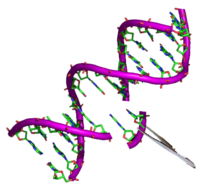
Photo from wikipedia
Abstract Agrobacterium- mediated genetic transformation approach allows for introducing novel genes in cotton ( Gossypium hirsutum L.). Development of efficient regeneration and transformation protocol is very important for recalcitrant plants… Click to show full abstract
Abstract Agrobacterium- mediated genetic transformation approach allows for introducing novel genes in cotton ( Gossypium hirsutum L.). Development of efficient regeneration and transformation protocol is very important for recalcitrant plants like cotton. In the present study, five-day-old germinated mature embryo parts especially embryonic axis, hypocotyl and plumule of cotton ‘Lashata’ were wounded and inoculated with A. tumefaciens strain GV2260 harbouring plasmid p35S-GUS-INT. The binary plasmid p35S-GUS-INT contains neomycin phosphotransferase II ( NPTII ) gene driven by nopaline synthase ( NOS ) promoter and β-glucuronidase ( GUS ) gene controlled by cauliflower mosaic virus (CaMV) 35S promoter. After inoculation, explants were co-cultivated in liquid and agar-solidified MS medium for 48 h in dark condition. Agar-solidified co-cultivation medium increased transformation frequency as compared to liquid medium. The putative primary transformants were confirmed with histochemical GUS assay, PCR and RT-PCR. However, comparing the three culture explant, the embryonic axis explants had significant difference with embryonic hypocotyl and plumule explants in terms of number and percentage (%) of GUS, PCR and RT-PCR positive plant. The total transformation efficiency was recorded as 3% with varying GUS expression levels.
Journal Title: Russian Journal of Plant Physiology
Year Published: 2020
Link to full text (if available)
Share on Social Media: Sign Up to like & get
recommendations!